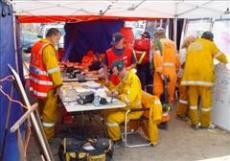Information flow and collaborative work in IMT and multi-agency operations.
Enhancing Emergency Incident Management Team Effectiveness and Organisational Learning
Led by University of Tasmania education senior lecturer Dr Christine Owen, this project has studied communications among members of incident management teams working under the Australasian Inter-service Incident Management System (AIIMS).
How best is an Incident Management Team established when its members come from a variety of different agencies, each with its own mindset and viewpoint about making decisions? The project sought to gain a sound understanding of communications flows through the AIIMS structure. The researchers conducted many observations of IMTs in action, looking at, for example, how best to lay out an Incident Control Centre.
Timely interactions and collaborations within and between both same-site and geographically isolated teams are crucial for achieving seamless information flow and coordinated effective action. Communication breakdowns in such teams of even a minor nature can easily lead to unnecessary and unacceptable property loss at best, or life threatening consequences at worst.
The research has led to a better understanding of the ways in which incident management teams work together, a better understanding of how information flows through organisations and the way knowledge is managed before, during and after incidents and a better understanding of what enables and constrains successful IMT operations and information flow.
The research indicated that the current incident control systems work well under routine emergency events but are strained under escalated conditions, when emergencies are complex, where there are high numbers of people involved, and where there are multi agencies involved. Changes to various parts of AIIMS were suggested.
Dr Owen says the work has led to improved training strategies in communication, teamwork and coordination of incident management operations, with enhanced reliability and responsiveness of IMT operations at times of fire. Several industry workshops and presentations have taken place.
“The application of the findings will lead to improvements in preparedness and collective action that will mitigate the effects of future disasters in Australia,” she added.
This project had several University of Tasmania postgraduate projects associated with it. Greg Hickey looked at how information flow is conducted when many organisations suddenly respond together in a bushfire incident. Jan Douglas investigated teamwork effectiveness in incident management teams undertaking simulation training. Ian Dwyer examined communication strategies and collaborative work practices in IMTs.
The breakthrough findings of this project have significantly raised awareness in partner agencies of the need for more research in this area. Consequently, further research is being conducted under the new Bushfire CRC Research Extension program and several related studies have been commissioned under contract arrangements with individual agencies.


Related News
Publications from this Project
Report
Journal Article
External References
Christine Owen is a project leader for Bushfire CRC research on incident management systems. She was interviewed at the 2010 annual conference.
Staff ride for a Narawntau planned burn, Tasmania Parks and Wildlife Service. Filmed with the support of the Bushfire CRC.










